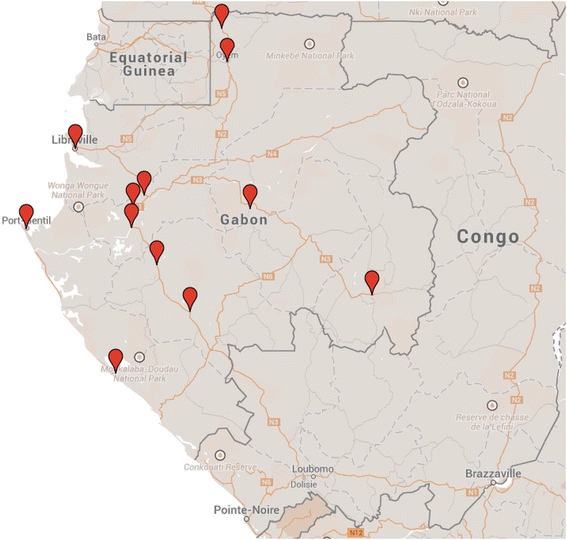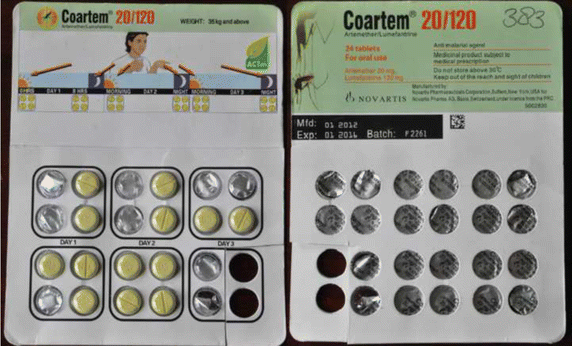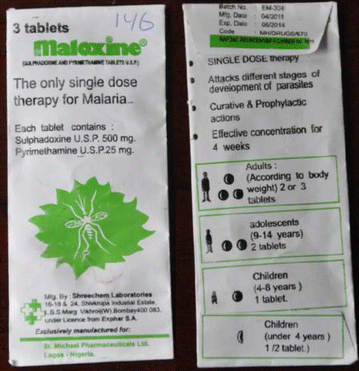Assessing the quality of anti-malarial drugs from Gabonese pharmacies using the MiniLab®: a field study
- PMID: 26169915
- PMCID: PMC4501108
- DOI: 10.1186/s12936-015-0795-z
Assessing the quality of anti-malarial drugs from Gabonese pharmacies using the MiniLab®: a field study
Abstract
Background: Recent studies alluded to the alarming scale of poor anti-malarial drug quality in malaria-endemic countries, but also illustrated the major geographical gaps in data on anti-malarial drug quality from endemic countries. Data are particularly scarce from Central Africa, although it carries the highest burden of malaria. The aim of this medicine quality field survey was to determine the prevalence of poor-quality anti-malarial drugs in Gabon.
Methods: A field survey of the quality of anti-malarial drugs in Gabonese pharmacies was conducted using the Global Pharma Health Fund Minilab(®) tests, following the Medicine Quality Assessment Reporting Guidelines. Anti-malarial drugs were purchased randomly from selected pharmacies in Gabon. Semi-quantitative thin-layer chromatography (TLC) and disintegration testing were carried out to measure the concentration of active pharmaceutical ingredients (APIs). The samples failing the TLC test were analysed by high-performance liquid chromatography. Following the collection of anti-malarial drugs, a street survey was conducted to understand where people purchase their anti-malarial drugs.
Results: A total of 432 samples were purchased from 41 pharmacies in 11 cities/towns in Gabon. The prevalence of poor-quality anti-malarial drugs was 0.5% (95% CI 0.08-1.84%). Two out of 432 samples failed the MiniLab(®) semi-quantitative TLC test, of which a suspected artemether-lumefantrine (AL) sample was classified as falsified and one sulfadoxine-pyrimethamine (SP) sample as substandard. High performance liquid chromatography with ultraviolet photo diode array detection analysis confirmed the absence of APIs in the AL sample, and showed that the SP sample did contain the stated APIs but the amount was half the stated dose. Of the people interviewed, 92% (187/203) purchased their anti-malarial drugs at a pharmacy.
Conclusion: Using the GPHF Minilab(®), the prevalence of poor-quality anti-malarial drugs is far lower than anticipated. The findings emphasize the need for randomized and robust sampling methods in order to collect representative data on anti-malarial drug quality.
Trial registration: NTR4341 (Dutch Trial Registry).
Contexte: Des études récentes ont fait allusion à l'ampleur alarmante sur la qualité des médicaments antipaludiques dans les pays d'endémie. Elles ont aussi illustré les principales lacunes des données géographiques concernant les médicaments antipaludiques dans les pays endémiques. Les données sont particulièrement rares en Afrique centrale, bien que cette région porte le plus lourd fardeau du paludisme. Le but de cette enquête sur le terrain était de déterminer la prévalence des médicaments antipaludiques de mauvaise qualité au Gabon.
Méthodes: Une enquête sur le terrain a été réalisée sur la qualité des médicaments antipaludiques dans les pharmacies gabonaises en utilisant les tests ‘Global Pharma Health Fund Minilab®’, suivant la ‘Medicine Quality Assessment Reporting Guidelines (MEDQUARG)’. Les médicaments antipaludiques ont été achetés dans des pharmacies choisies au hasard au Gabon. La chromatographie semi-quantitative en couche mince (CCM) et le test de désintégration ont été effectués pour mesurer la concentration d'ingrédients pharmaceutiques actifs (API). Les échantillons qui n’ont pas réussi le test CCM ont été analysés par chromatographie en phase liquide à haute performance. Après la collecte des médicaments antipaludiques, une enquête communitaire a été menée pour comprendre où les gens achètent leurs médicaments.
Résultats: Un total de 432 échantillons ont été achetés dans 41 pharmacies de 11 villes au Gabon. La prévalence de médicaments antipaludiques de mauvaise qualité était de 0,5% (IC 95% de 0,08 à 1,84%). Sur les 432 échantillons, le test semi-quantitatif de chromatographie sur couche mince Minilab® n’a permis de détecter aucune substance active sur deux échantillons, dont un échantillon d’artéméther-luméfantrine (AL) suspecté contrefait et un échantillon de sulfadoxine-pyriméthamine (SP) ont été classées échantillon de qualité inférieure. L’analyse pour la détection d’APIs dans l’échantillon AL par chromatographie liquide à haute performance avec photo ultraviolet de réseau de diodes a confirmé l'absence d'API et a montré que l'échantillon de SP contient les énoncés API mais la quantité était la moitié de la dose indiquée. Parmi les personnes interrogées, 92% (187/203) ont acheté leurs médicaments dans une pharmacie.
Conclusion: L'utilisation du GPHF Minilab®, la prévalence des médicaments antipaludiques de mauvaise qualité est grandement inférieur à celle prévue. Les résultats soulignent la nécessité pour les méthodes d'échantillonnage aléatoire et robustes afin de recueillir des données représentatives sur la qualité des médicaments antipaludiques.
Electronic supplementary material: The online version of this article (doi:10.1186/s12936-015-0795-z) contains supplementary material, which is available to authorized users.
Figures




Similar articles
-
Use of thin-layer chromatography to detect counterfeit sulfadoxine/pyrimethamine tablets with the wrong active ingredient in Malawi.Malar J. 2016 Apr 14;15:215. doi: 10.1186/s12936-016-1259-9. Malar J. 2016. PMID: 27075749 Free PMC article.
-
The diagnostic accuracy of the hand-held Raman spectrometer for the identification of anti-malarial drugs.Malar J. 2016 Mar 15;15:160. doi: 10.1186/s12936-016-1212-y. Malar J. 2016. PMID: 26975570 Free PMC article.
-
Surveillance for falsified and substandard medicines in Africa and Asia by local organizations using the low-cost GPHF Minilab.PLoS One. 2017 Sep 6;12(9):e0184165. doi: 10.1371/journal.pone.0184165. eCollection 2017. PLoS One. 2017. PMID: 28877208 Free PMC article.
-
Combating poor-quality anti-malarial medicines: a call to action.Malar J. 2016 Jun 1;15:302. doi: 10.1186/s12936-016-1357-8. Malar J. 2016. PMID: 27251199 Free PMC article. Review.
-
An empirical review of antimalarial quality field surveys: the importance of characterising outcomes.J Pharm Biomed Anal. 2018 Jan 5;147:612-623. doi: 10.1016/j.jpba.2017.04.056. Epub 2017 May 8. J Pharm Biomed Anal. 2018. PMID: 28549854 Review.
Cited by
-
Prevalence of substandard, falsified, unlicensed and unregistered medicine and its associated factors in Africa: a systematic review.J Pharm Policy Pract. 2024 Jul 15;17(1):2375267. doi: 10.1080/20523211.2024.2375267. eCollection 2024. J Pharm Policy Pract. 2024. PMID: 39015754 Free PMC article. Review.
-
Prevalence and Estimated Economic Burden of Substandard and Falsified Medicines in Low- and Middle-Income Countries: A Systematic Review and Meta-analysis.JAMA Netw Open. 2018 Aug 3;1(4):e181662. doi: 10.1001/jamanetworkopen.2018.1662. JAMA Netw Open. 2018. PMID: 30646106 Free PMC article.
-
Characterizing Medicine Quality by Active Pharmaceutical Ingredient Levels: A Systematic Review and Meta-Analysis across Low- and Middle-Income Countries.Am J Trop Med Hyg. 2022 Jun 15;106(6):1778-1790. doi: 10.4269/ajtmh.21-1123. Print 2022 Jun 15. Am J Trop Med Hyg. 2022. PMID: 35895431 Free PMC article.
-
Anti-malarial medicine quality field studies and surveys: a systematic review of screening technologies used and reporting of findings.Malar J. 2017 May 15;16(1):197. doi: 10.1186/s12936-017-1852-6. Malar J. 2017. PMID: 28506234 Free PMC article.
-
Global research on artemisinin and its derivatives: Perspectives from patents.Pharmacol Res. 2020 Sep;159:105048. doi: 10.1016/j.phrs.2020.105048. Epub 2020 Jun 23. Pharmacol Res. 2020. PMID: 32590098 Free PMC article.
References
-
- WHO (2014) Malaria Factsheet No 94. World Health Organization (WHO). http://www.who.int/mediacentre/factsheets/fs094/en/. Accessed 11 Feb 2015
MeSH terms
Substances
LinkOut - more resources
Full Text Sources
Other Literature Sources

